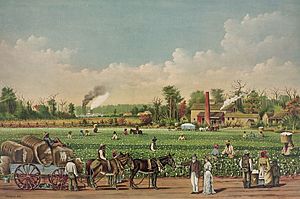Sectionalism facts for kids
Sectionalism means being loyal to your own part of a country, rather than to the whole country. It's like preferring your state or region over the entire nation. This can lead to different areas having different ideas and goals.
Sectionalism happens in many countries. For example, in the United Kingdom, people in Scotland have strong feelings about their region. Groups like the Scottish National Party (SNP) want Scotland to have more control over its own affairs. Some even want Scotland to become a completely independent country.
Contents
Sectionalism in the United States
In the 1800s, sectionalism in America was about the big differences between the North and the South. They had different ways of life, social rules, and political beliefs.
North vs. South: A Growing Divide
These regional differences became very clear during the War of 1812. The North was unhappy with trade rules that hurt its factories. This led to meetings like the Hartford Convention. Other issues also caused tension, such as the Three-Fifths Compromise and new states joining the Union. Many early presidents were from the South, which also bothered the North.
From 1800 to 1850, the North became more industrial. Cities grew, and factories made many goods. Meanwhile, the deep South focused on large farms called plantations. These farms relied on slave labor. Poor white farmers in the South often grew just enough food for themselves.
Southerners defended slavery by saying their enslaved workers were better cared for than Northern factory workers. They even called Northern workers the "white slaves of the North."
Economy and Society Differences
Even though some people in the West and religious leaders spoke out against slavery, Northern businesses still benefited from it. The South expanded into new, rich lands in states like Alabama and Texas. However, slavery was fading in border states and cities like Baltimore, Louisville, and St. Louis. This meant the South, with its slavery system, stayed mostly rural and non-industrial.
As the demand for cotton grew, the price of enslaved people went up. This was because enslaved people were seen as essential for growing and processing cotton. Historians have discussed whether these economic differences caused the Civil War. Some now believe the North and South actually helped each other's economies.
However, historians agree that social and cultural life was very different. In the South, wealthy white men owned the best land. This left poor white farmers with less productive land. Southerners also worried a lot about slave revolts. They were very against new ideas that might challenge their way of life.
Political and Religious Splits
The newly formed Republican Party strongly criticized Southern society. They argued that the North's system of free labor led to more success. Republicans pointed to the North's faster growth in population, factories, farms, and schools. They saw this as proof that free labor was better.
Southerners argued that the North was changing too much. They felt the South was sticking to the original republican values of the Founding Fathers. Many Founding Fathers, like Washington and Jefferson, had owned slaves.
The issue of slavery even split major religious groups. The Methodist, Baptist, and Presbyterian churches divided into separate Northern and Southern branches. Also, most European immigrants settled in the North. Twice as many white people moved from the South to the North. These changes made the South feel defensive and aggressive in its politics.
Sectionalism also appeared in the American West. In the late 1800s, farmers felt that Eastern railroads were taking advantage of them. This led them to support the Populist political movement.
Sectionalism in Spain
You can also find sectionalism in parts of Spain. Regions like Catalonia, the Basque Country, Galicia, and Andalusia all have strong regional identities.
Sectionalism in Ukraine
After the Soviet Union broke apart in 1991, Ukraine became an independent country. However, some parts of Ukraine, especially in the east, had many Russian people. This led to some conflicts. There were rebellions in areas that declared themselves the Donetsk People's Republic and the Luhansk People's Republic. The Crimea peninsula is also a disputed area. Many countries do not agree with Russia's takeover of Crimea.
Sectionalism in Canada
In 1977, the Canadian province of Quebec started a movement to become independent from Canada. Quebec is mostly French-speaking and wanted to be its own nation. There were two votes (in 1980 and 1995) on whether Quebec should stay part of Canada. Both votes failed, and Quebec remains a province of Canada.
In the northern parts of Canada, the government has given the native Inuit people some self-governance. This allows them to keep their cultural practices in areas like the Yukon, Northwest Territories, and Nunavut.


